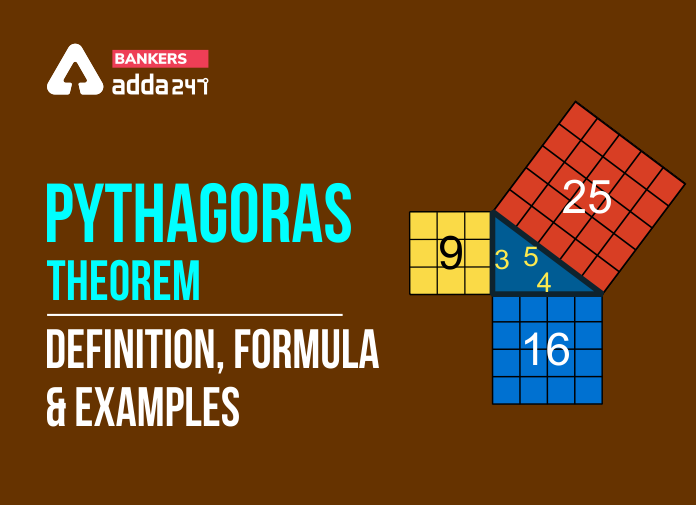A very common and important topic in Mathematics, Pythagoras Theorem, or the Pythagorean Theorem. It explains the relation between the different sides of a right-angled triangle. The theorem states that “In a right-angled triangle, the square of the hypotenuse is equal to the sum of the squares of the other two sides of the triangle.”
Practice With,
The other two sides here are the Perpendicular and the Base of the triangle. Therefore, in a right-angled triangle, the Hypotenuse becomes its longest side, since it is opposite to the 90° angle.
FORMULA OF PYTHAGOREAN THEOREM
In a right-angled triangle,

A is the Perpendicular
B is the Base
C is the Hypotenuse
Therefore, according to the definition of the Pythagorean Theorem, the formula would be:
Hypotenuse²= Perpendicular² + Base²
In other words, it would be:
C²= A²+ B²
Click Here to Register for Bank Exams 2020 Preparation Material
Also Read,
| List of Presidents | List of Prime Ministers | Largest State of India | Governers of RBI |
| What is PMJDY ? | List of Cabinet Ministers | National Security Act | Chief Election Commissioner of India |
PROOF OF PYTHAGORAS THEOREM:
In a right-angled triangle, the base and the perpendicular together make up an angle of 90 degrees with each other. therefore, according to the Pythagorean Theorem, “the square of the hypotenuse is equal to the sum of a base square and perpendicular square.”
In order to prove this theorem,
Let us suppose a triangle ABC, which is right-angled at B.

We have to prove that: AC²= AB² + BC²
To explain: We draw a perpendicular line BD which meets AC at D.
Proof:
We know by the theorem that if a perpendicular is drawn from the vertex of the right angle to the hypotenuse of a right-angled triangle, then the two triangles on both the sides of the perpendicular are similar to each other as well as to the whole triangle.
Therefore,
△ADB ~ △ABC
Hence,
AD/AB = AB/AC (Condition for similarity)
Or, AB2 = AD × AC (1)
Also, △BDC ~△ABC (By applying the same theorem)
Therefore,
CD/BC = BC/AC (Condition for similarity)
Or,
BC2= CD × AC (2)
Now,
By adding the equations (1) and (2) we get,
AB2 + BC2 = AD × AC + CD × AC
AB2 + BC2 = AC (AD + CD)
Since, AD + CD = AC
Therefore, AC2 = AB2 + BC2
Hence, the Pythagorean theorem is proved.
APPLICATIONS OF PYTHAGOREAN THEOREM
Some applications of the Pythagoras Theorem are:
- To know whether the triangle is a right-angled triangle or not
- To find the diagonal of a square
- In a right-angled triangle, we can calculate the length of any side if we know the length of the other two sides
Frequently Asked Questions- Pythagoras Theorem
Q. How do you find the Pythagorean Theorem?
In a right-angled triangle, Hypotenuse²= Perpendicular² + Base²
Q. What is Pythagoras Theorem?
It is a fundamental theorem of Mathematics that defines the relationship between three sides of a right-angled triangle.
Q. What is the Pythagorean theorem in simple terms?
Simple definition of Pythagorean theorem is that the square of the length of the hypotenuse of a right triangle equals the sum of the squares of the lengths of the other two sides.
Q. How is the Pythagorean Theorem useful in real life?
This theorem is useful in architecture, construction projects, woodworking and other such projects, where you need to calculate the length of the diagonal connecting given two straight line.



 Weekly Current Affairs One Liners 23rd t...
Weekly Current Affairs One Liners 23rd t...
 CSIR CRRI Typing Test 2025 Date for JSA ...
CSIR CRRI Typing Test 2025 Date for JSA ...
 Can Final Year Students Apply for SBI PO...
Can Final Year Students Apply for SBI PO...


